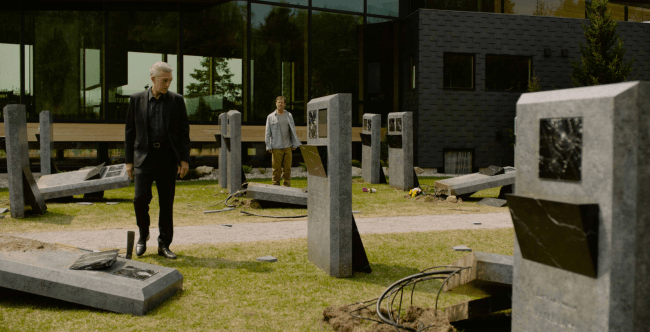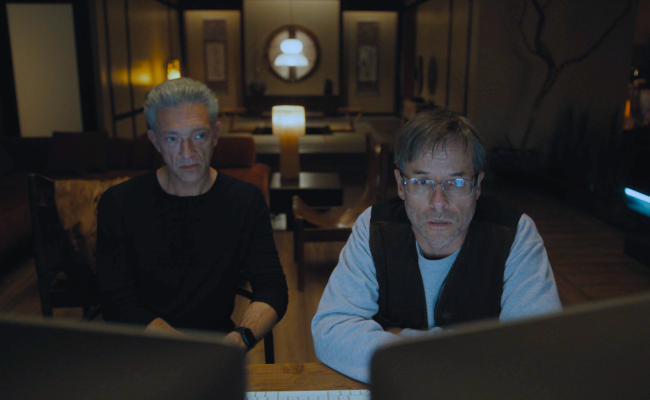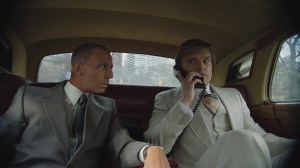
Inspired by the loss of the director’s wife, “The Shrouds” is a story of grief as only David Cronenberg could have thought of making one: sardonic, unsentimental and often so stiff that the film itself seems to suffer from rigidity cadaverous, as shown if his images died at some point during their brief journey from projector to screen. And really, what else can you expect? I suppose it’s possible that the deeply personal context of the story prompted Cronenberg to object to the tender sterility of his recent features, or even to dare to expose the soft underbelly that has always lurked in his tumorous work and its many layers of horror. beautiful new flesh. If so, it appears almost immediately that he had no interest in accepting this invitation.
A typically late film from an artist who was always ahead of his time, “The Shrouds” is Cronenberg at his most inhospitable; When it comes to the project’s emotional availability and commercial appeal, “Crimes of the Future” feels like “Barbie” in comparison. And yet, as in so many of Cronenberg’s most resonant films, his morgue-like coldness ultimately proves deeply comforting to some extent – if not while you’re watching him, at least perhaps when his big ideas begin to seep into your bones. marrow during the days and weeks that follow.
Between its paranoid plot and a protagonist who becomes increasingly difficult to view as anything other than an avatar for its author, “The Shrouds” lends itself to a kind of delayed appreciation; its story only makes sense with the detached perspective that might begin to develop between the death of a loved one and the funeral service at which they are laid to rest. The body is reality, Cronenberg likes to say, but what happens to this reality when the body in question is buried six feet underground?
“The Shrouds” initially stands out from the rest of its director’s body of work because it focuses less on the flesh than on the bones beneath it; at the beginning of the film, all traces of skin have already rotted on the body of the main character’s late wife. She’s been dead for four years, which was apparently long enough for her widow – a Toronto futurist and “industrial video producer” – to create a well-funded proof of concept for a bold new innovation in bereavement.
His name is Karsh, he’s played by a smiling Vincent Cassel (whose slab-shaped face and straight gray hair make him a Cronenberg look-alike, even before he wears the sunglasses that complete the illusion), and the sophisticated technology that gave him his Tesla is called “GraveTech”, a start-up that designates a wired cemetery that allows mourners to watch their loved ones rot in real time, either with an application on their telephone, or via the monitors affixed to the top of each tombstone. It is in fact a cinema of the dead, as so many conventional films have become since they were made.
That night, it’s possible that real cameras are involved in the GraveTech process, but most of the data that comes back from the afterlife is generated by the radioactive envelopes that Karsh slides his corpses into before they are buried; imagine the kind of sexy funeral dress that could make its Fashion Week debut and you’ll have the right idea. At the very least, you’ll understand why this is one of several Cannes films co-financed this year by Yves Saint Laurent’s production arm.
Karsh believes his morbid invention will allow people to maintain a meaningful relationship with their life partner’s body, even after death. His personal experience suggests that installing an open window in a closed casket might help stabilize the disorientation that follows a devastating loss, if only because the possibility of seeing a deceased spouse as he or she decomposes on a screen could give the dead a more literal and continuous vision. present than an offline coffin could ever do, preserving them as a fact rather than an idea. Where is Karsh’s wife? Well, she’s right under the lawn outside her restaurant, and you can actually FaceTime with her whenever you want (yes, our man built a slate gray restaurant next to GraveTech’s test cemetery, a biting testimony to his “life goes on” ethos as well as the biting and hilarious blind date setting he enjoys at the start of the film, which proves typical of the very dry wit to come).
It’s a relatively safe and sound concept, at least considering the very low technological standards created by someone in a David Cronenberg movie, and it seems to serve its purpose for Karsh and his clients. But there are… complications. On the one hand, GraveTech wasn’t able to stop Karsh’s teeth from eroding from grief – it’s perhaps the talkiest film Cronenberg ever made, prone to logorrhea verbal even greater than the one we had with “A Dangerous Method”, but its characters express themselves even better through their bodies than through their words.

On the other hand, GraveTech is being traumatized by a mysterious group that seems to have a problem with the ethics of Karsh’s technology and may or may not have anything to do with the Hungarian billionaire who wants to franchise the company across the world . Such enemies, whatever they may be, reflect the incongruity of a tool that promises its clients a kind of stasis at odds with the mutability of our mortal forms, even in death (all the trouble begins when Karsh notices new bone deposits developing in the nasal cavity of his deceased wife). Aside from his French accent, Karsh’s inability to anticipate this dilemma is perhaps the most obvious difference between him and the director he so ostensibly resembles, who has made this tender conceit the subject of his work for so many years. decades.
Alas, Karsh is a fictional replacement for David Cronenberg instead of the real McCoy, which means he’s filled with fanciful hopes and surrounded by characters who exist only to confuse them. Characters like Diane Kruger’s Terry, a prickly dog groomer and the sister of her Karsh’s late wife Becca, who looks exactly like him. What psychological stress could this cause for a man so determined to stay in touch with his wife that he created a surveillance camera on which he could spy on her for eternity? And just to add injury to insult, Kruger Also plays Becca, appearing naked in a morose series of nightmares in which Karsh relieves the various mutilating surgeries his wife underwent as part of her cancer treatment at the hands of a doctor she previously dated.

Kruger’s performance in these segments of the film is as sincere and haunting as his incarnation of Terry is barbed and menacing, and this moving duality – galvanized by one of the most gripping psychosexual love scenes in recent memory – would be more than enough to make this happen. the best work of his career even if it is not the case Also play as the AI assistant who organizes Karsh’s life. But she does it, and boy is its coding Siri has some bugs to work out. That would be a job for Terry’s ex-husband Maury (Guy Pearce in “Iron Man 3” mode as a frayed and surprisingly convincing beta nerd who can’t move on because the woman he lost still lives just down the street). Hunny, as the AI is called, is another facet of this film’s multifaceted obsession with the notion of body hacking and the unknown extent to which technology could be used to cheat grief.
Ever the pragmatist, Cronenberg knows better than to fall into this trap himself, but does that make him cruel to have organized Karsh’s entire life around the same principle? That question will become a seductive lifeline as “The Shrouds” moves away from a coherent narrative logic and begins to wade into the murky waters of international conspiracy and accusations of schizophrenia — slowly at first, but then so quickly that we can no longer tell which direction it is heading. up.
Cassel’s slowly eroding intelligence makes it quite amusing to watch Karsh navigate his way deeper and deeper into the maze of his own emotions (presumably to spare Cronenberg from suffering the same fate), even if the direction is so calm and antiseptic like that. we often have the impression that the film is not moving forward at all. The flat aesthetic — and Howard Shore’s complementary score, which provides the same numbing buzz he gave to “Crimes of the Future” — suits the story of a man struggling to deny the colorlessness of life after the loss, and looking in all the wrong places for dynamism that could take its place. “I lived in Becca’s body,” he tells someone, in a vintage piece of Cronenbergian syntax. “It was the only place I really lived.”
“The Shrouds” is therefore a film about Karsh’s quest for a new home, which is made impossible by his painful desire to return to his old one. It’s a spiraling maze to nowhere in which the only way out is to make peace with the fact that there isn’t one, and with every plot detail Cronenberg throws into the mix – of the relationship Karsh’s torture with Terry to his flirtation with a blind woman. and his Skype conflict with someone on a volcano in Iceland – amounts to a red herring in the hero’s quest to end a feeling he carries with him wherever he goes. Avoiding reality only complicates it; the shrouds don’t allow Karsh to see his deceased wife more clearly, they obscure his ability to see real life.
Ours too, to a certain extent. What I love about “The Shrouds”, and why I can’t stop thinking about it, is that the ultimate value of GraveTech is still unresolved. Although I would argue that Cronenberg does not display great confidence in the purported function of this technology of death, that does not prevent him from seeing a measure of quixotic and all-too-human gentleness in Karsh’s quest for signs continuous life. Becca is gone and no trick of the imagination will bring her back. There’s something to be said for the old-fashioned brain hack that out of sight, you don’t think. But how beautiful it is that we always look for our loved ones in the world, even though we know exactly where to find them.
Grade: A-
“The Shrouds” was presented in competition at the 2024 Cannes Film Festival. It is currently seeking distribution in the United States.

